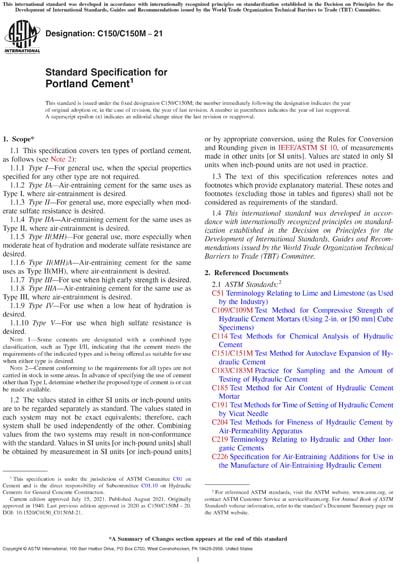Historical
ASTM C150/C150M-21
Standard Specification for Portland Cement
1.1This specification covers ten types of portland cement, as follows (see Note 2):
1.1.1Type I - For general use, when the special properties specified for any other type are not required.
1.1.2Type IA - Air-entraining cement for the same uses as Type I, where air-entrainment is desired.
1.1.3Type II - For general use, more especially when moderate sulfate resistance is desired.
1.1.4Type IIA - Air-entraining cement for the same uses as Type II, where air-entrainment is desired.
1.1.5Type II(MH) - For general use, more especially when moderate heat of hydration and moderate sulfate resistance are desired.
1.1.6Type II(MH)A - Air-entraining cement for the same uses as Type II(MH), where air-entrainment is desired.
1.1.7Type III - For use when high early strength is desired.
1.1.8Type IIIA - Air-entraining cement for the same use as Type III, where air-entrainment is desired.
1.1.9Type IV - For use when a low heat of hydration is desired.
1.1.10Type V - For use when high sulfate resistance is desired.
Note 1:Some cements are designated with a combined type classification, such as Type I/II, indicating that the cement meets the requirements of the indicated types and is being offered as suitable for use when either type is desired.
Note 2:Cement conforming to the requirements for all types are not carried in stock in some areas. In advance of specifying the use of cement other than Type I, determine whether the proposed type of cement is or can be made available.
1.2The values stated in either SI units or inch-pound units are to be regarded separately as standard. The values stated in each system may not be exact equivalents; therefore, each system shall be used independently of the other. Combining values from the two systems may result in non-conformance with the standard. Values in SI units [or inch-pound units] shall be obtained by measurement in SI units [or inch-pound units] or by appropriate conversion, using the Rules for Conversion and Rounding given in IEEE/ASTM SI 10, of measurements made in other units [or SI units]. Values are stated in only SI units when inch-pound units are not used in practice.
1.3The text of this specification references notes and footnotes which provide explanatory material. These notes and footnotes (excluding those in tables and figures) shall not be considered as requirements of the standard.
1.4This international standard was developed in accordance with internationally recognized principles on standardization established in the Decision on Principles for the Development of International Standards, Guides and Recommendations issued by the World Trade Organization Technical Barriers to Trade (TBT) Committee.
Content Provider
ASTM International [astm]






